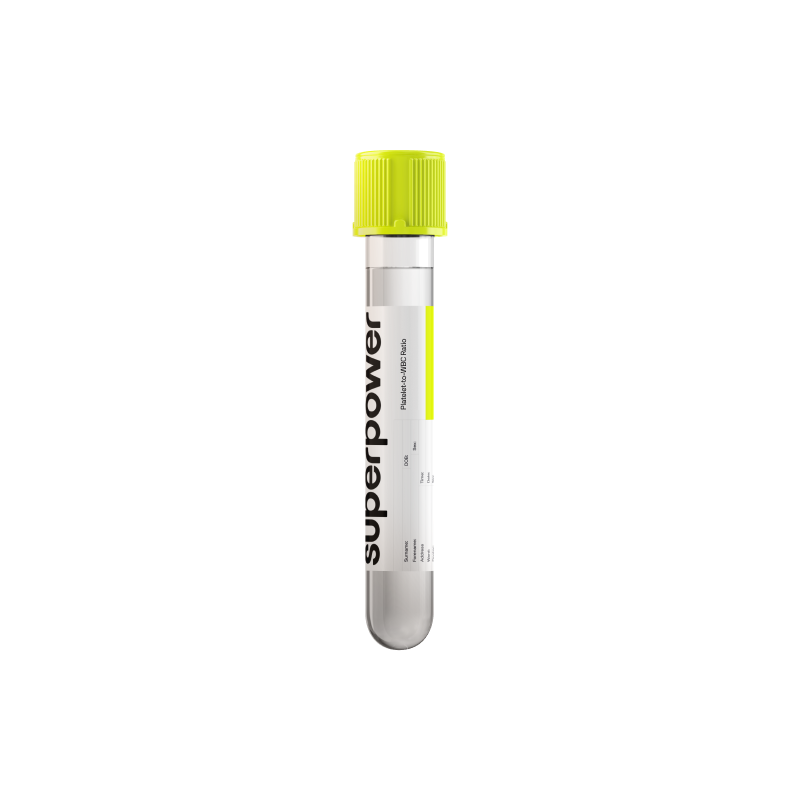The Platelet-to-WBC Ratio is calculated by dividing platelet count by total white blood cell count. A lower ratio suggests stronger immune activation or fewer platelets, while a higher ratio reflects more platelets or lower WBCs.
This index integrates two key CBC signals into one number that’s easy to trend over time.
Key Benefits
- Check the balance between clotting platelets and infection-fighting white blood cells.
- Spot early infection or inflammation when white cells rise and platelets lag.
- Clarify easy bruising by showing if platelets are low relative to white cells.
- Guide next steps if results suggest bone marrow stress or medication effects.
- Add context in chronic liver disease, where platelets fall and infections raise WBC.
- Track recovery after illness as white cells normalize and platelets rebound toward baseline.
- Support surgical planning by balancing bleeding and infection risks alongside a full CBC.
- Best interpreted with a full CBC differential, trends, and your symptoms.
What is Platelet-to-WBC Ratio?
The platelet-to-WBC ratio is the number of platelets divided by the number of white blood cells in your blood. Platelets (thrombocytes) are tiny cell fragments released by large bone-marrow cells called megakaryocytes. White blood cells (leukocytes) are immune cells—neutrophils, lymphocytes, monocytes, and others—made in the bone marrow and lymphoid tissues. Both circulate continuously and are renewed as the body’s needs change. The ratio doesn’t measure a new substance; it combines two fundamental blood cell counts into one index.
This ratio reflects the balance between clot-and-repair capacity and immune/inflammatory activity. Platelets help seal injured vessels and coordinate healing while also sending chemical signals (hemostasis and tissue repair). White blood cells detect and respond to microbes, injury, and stress (innate and adaptive immunity). When considered together, their relative abundance offers a compact view of marrow output, peripheral consumption, and the body’s current demand for repair versus defense. In this way, the platelet-to-WBC ratio provides an integrated snapshot of hematologic homeostasis—a way to sense how the blood’s clotting and immune systems are proportioned at a given moment.
Why is Platelet-to-WBC Ratio important?
The platelet-to–white blood cell (WBC) ratio captures the balance between clotting capacity (platelets) and immune activation (WBCs). Because these cell lines respond in opposite directions to stress—platelets fall with consumption or marrow suppression, WBCs rise with infection—the ratio serves as a quick readout of whole‑body inflammation, marrow health, and vascular risk. There is no universal reference range; interpretation is lab- and context-specific. In stable adults, values clustering near the middle of a lab’s range and steady over time are typically reassuring, while abrupt shifts are more meaningful than small differences.
When the ratio is on the low side, it usually reflects high WBCs, low platelets, or both. That pattern is common in acute infections, sepsis, major tissue injury, autoimmune platelet destruction, disseminated intravascular coagulation, or drug/viral marrow suppression. People may notice fever, fatigue, fast heart rate, easy bruising, nosebleeds, or pinpoint skin spots. Systemically, endothelial inflammation, capillary leak, and platelet consumption can impair oxygen delivery and raise bleeding risk. Pregnancy often lowers the ratio because WBCs rise and platelets trend slightly down; a marked drop with symptoms raises concern for hypertensive disorders (for example, HELLP). Children naturally have higher WBC counts, so their ratios run lower than adults.
When the ratio is high, it reflects higher platelets, lower WBCs, or both. Reactive thrombocytosis (iron deficiency, inflammation, postsplenectomy) or myeloproliferative disease can drive it up and may signal a more prothrombotic milieu; conversely, leukopenia from viruses, medications, or autoimmune disease raises infection vulnerability even if the ratio is high.
Big picture: this ratio links immunity, coagulation, marrow output, and vascular integrity. Tracked alongside absolute counts, it helps flag inflammatory load, bleeding or clotting tendency, and immune competence—key determinants of recovery, organ health, and long‑term outcomes.
What Insights Will I Get?
What Platelet-to-WBC Ratio tells you
This ratio compares platelet count to white blood cell count, integrating two core hematologic systems: clotting (platelets) and host defense (leukocytes). It acts as a compact readout of marrow allocation and inflammatory tone, with implications for vascular stability, infection resilience, tissue repair, and overall metabolic demand.
Low values usually reflect a surge in white cells (leukocytosis) from acute infection, inflammation, or physiologic stress, and/or a drop in platelets (thrombocytopenia) from consumption, marrow suppression, or hypersplenism. Systemically this signals high cytokine activity and endothelial stress, often accompanied by catabolic physiology and, if platelets are low, a greater bleeding tendency. Pregnancy commonly lowers the ratio due to higher WBCs and modestly lower platelets.
Being in range suggests balanced hematopoiesis with neither excessive inflammatory drive nor prothrombotic tendency. This typically aligns with stable endothelial function, effective but contained immune activity, and steady microcirculatory flow. There is no universal consensus on a single “optimal” point; mid-range within a lab’s reference interval is generally interpreted as physiologic balance.
High values usually reflect increased platelets (reactive thrombocytosis from chronic inflammation, iron deficiency, recovery from blood loss, or postsplenectomy) and/or low white cells (leukopenia) from viral suppression, marrow inhibition, autoimmune destruction, or cytotoxic medications. Systemically this can indicate a tilt toward clotting (thrombotic risk) or reduced immediate immune reserve.
Notes: Interpretation is context-dependent. Age, sex (women often have slightly higher platelets), pregnancy, recent infection, surgeries, and medications (glucocorticoids, chemotherapy, immune suppressants) shift the ratio. Acute exercise and stress transiently raise WBCs. Laboratory methods and timing of the draw introduce variability, so trends over time are more informative than a single value.



.svg)



.png)
.png)
.png)
.png)








